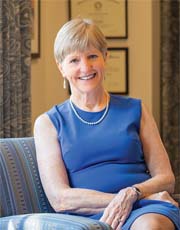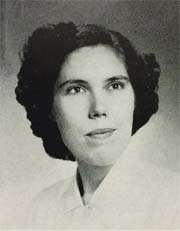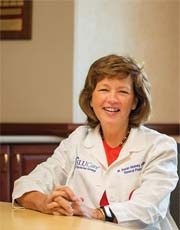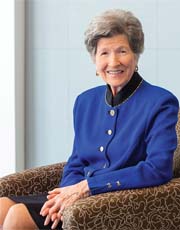Making History
Meet the Pioneers who Paved the way for the Next Generation of Women in Medicine and Science at Saint Louis University
Contributions by female researchers, physicians, and scientists at the Saint Louis University School of Medicine have changed the future of medicine, and opened new doors for women. at SLU, women have led the charge in a multitude of ways—providing powerful leadership, breaking down decades-old barriers, mentoring future scientists, and re-envisioning the role of women in science and medicine.
Their stories begin with a common thread: A passion for helping others. Curiosity about the world around them. A devotion to science and discovery. And the knowledge there was work to be done, no time to waste, and they were the people to do it.
Christine Jacobs, M.D., F.A.A.F.P.

Improving equity and access to health care while training the next generation of physicians has been a lifelong passion for Christine Jacobs, M.D., F.A.A.F.P., interim vice president of medical affairs and interim dean of the Saint Louis University School of Medicine. Since joining SLU in 2008, Dr. Jacobs has been instrumental in developing new programs, training new physicians, and leading the medical community in St. Louis and beyond.
Originally from California, Dr. Jacobs spent formative time in her early career in Appalachia, rural Illinois, and Africa, providing medical services for rural and underserved communities. “I’ve always had a commitment to improving access to health care,” she says. But melding that interest with her passion for teaching, she and her husband moved to Chicago, where she spent over two decades in academic family medicine.
Dr. Jacobs eventually moved to St. Louis for her husband’s position at Washington University in St. Louis.
“I was very attached to Chicago,” Dr. Jacobs says. “My patients were attached, my residents were attached. It was really a hard move.” But once Dr. Jacobs made the leap to St. Louis, she began to see she could make a tremendous difference. “One thing I love about SLU and St. Louis is the fact that you can accomplish a lot here,” she says. “Our community, our challenges, and our problems are right out in front of us. Because we’re a smaller place, you can actually do something about it. That’s been very appealing to me.”
Propelled by this ability to enact meaningful change, Dr. Jacobs’ contributions to SLU are immense. In 2011, she served as the founding program director of the SLU Family Medicine Residency and was awarded two HRSA grants. Her first program, the Longitudinal Underserved Community Curriculum, was designed to train family medicine residents to care for different populations in the greater St. Louis community — while simultaneously studying core challenges, such as addiction, child abuse, senior safety, and more.
“When you’re a doctor and you walk in the room with a patient, there’s a lot of performance pressure,” Dr. Jacobs says. “You need to be thinking, you need to get the diagnosis, you need to get the treatment. If we give residents time to experience and study these issues outside of the exam room, they can open up their minds and learn about them in different ways.”
Dr. Jacobs’ second initiative was the Family Medicine Behavioral Health Collaborative Curriculum, which offered training to family doctors in tandem with medical family therapists.
“I’ve always been interested in the intersection between behavioral health and physical health—this program trains the two types of providers side by side,” she says.
Dr. Jacobs became chair of the Department of Family and Community Medicine in 2017, where she established a new academic track for medical students at SLU—the Urban Community Health track.
“For four years, students are paired up with someone in underserved medicine,” Dr. Jacobs explains. “The goal is to give them that extra passion about working with an urban population.”
St. Louis, in particular, has its own unique set of challenges when it comes to the intersection of equity and health care.
“COVID has shone a light on issues that have been percolating in our community for so long,” Dr. Jacobs says. “For example, in St. Louis, the fear of health care in the Black community exists because we’ve done such a bad job in the past. COVID has resulted in disproportionate death rates in the Black community and now disproportionately low immunization because of a quite justified lack of trust.”
As interim dean, Dr. Jacobs sees her role as advancing SLU’s excellence in patient care, education and research through collaboration across the School of Medicine, Saint Louis University, and beyond. When she reflects on her work at SLU, she’s proud of what she’s achieved thus far.
“SLU is a place where you can have big ideas. We’re very committed to the community and we excel in that. To me, pursuing academic medicine at SLU is the pursuit of truth and scientific inquiry—while at the same time caring for our community. It’s a wonderful place to be.”
Mary Nawrocki, M.D.

Mary Nawrocki, M.D., now 97, has paved the way for future generations of women doctors in St. Louis and beyond. In 1948, she was the first woman to enter the Saint Louis University School of Medicine — and would later become the first woman inducted into the Alpha Omega Alpha Medical Honor Society. Since those milestones, Dr. Nawrocki pursued a decades-long career specializing in rehabilitation medicine in her adopted state of Pennsylvania, serving as a role model and icon for other female physicians and scientists.
“As an undergraduate at SLU, I was into the sciences and in those days, my classes were held in the medical school building,” Dr. Nawrocki remembers. “So I spent most afternoons there and I felt at home.”
Beyond breaking barriers for women, Dr. Nawrocki witnessed history in real time for Black students on February 11, 1944.
“I happened to be in the congregation on the day when Fr. Claude Heithaus made his famous homily, insisting that Black students be admitted to the university,” she remembers. “That was a big deal. That was a highlight.”
His words led to the first integration of a university in a former slave-holding state in the same year.
After finishing her undergraduate degree in 1945, Mary Nawrocki worked in Anheuser-Busch’s yeast plant laboratory for a year. “At that time, one of my professors came back to the biochemistry department from the service,” she says.
“I thought, ‘Well, I’ll go to graduate school and work in his lab’. But one day, another colleague who worked in the lab said to me, ‘I have a secret. [The School of Medicine is] going to start admitting women. Why don’t you apply?’”
Dr. Nawrocki jumped at the opportunity and was accepted—along with Catherine Carrol, a graduate assistant in bacteriology who would graduate one year later. One of Dr. Nawrocki’s favorite memories was during her gross anatomy lab.
“Catherine and I were assigned to one of the cadavers,” she remembers. “And the people in charge gave us the biggest, heaviest cadaver—but it was a wonderful specimen because it had wonderful muscle development. They thought they were playing a joke by giving us something heavy—but we did better.”
After her historic accomplishment of graduating from the SLU School of Medicine in 1952 as the first woman, Dr. Nawrocki accepted an internship at Philadelphia General Hospital, one of the oldest hospitals in the country at the time. 1952 was also the first time graduates were matched by computer with their internships.
“Rehabilitation medicine was a very new specialty in those days,” she says. “It had its impetus in World War II.”
Dr. Nawrocki worked at Philadelphia General Hospital for three more years — until she married in July of 1957 and moved to Pittsburgh, Pennsylvania. She would go on to have five children within six years, prompting her to take some time off from her career.
”The oldest was born in 1958 and the youngest was born in 1964.”
One day, Dr. Nawrocki received a phone call from the medical director of the Harmarville Rehabilitation Center who asked if she’d be interested in substituting for doctors on vacation. She said yes—and that temporary position eventually turned into a full-time role.
“Gradually, I worked there more and more,” she says. “I spent 27 years of my career at Harmarville Research Center.”
As she looks back on the evolution of medicine, Dr. Nawrockiis amazed at the many advancements.
“It’s almost as if I went to school in the middle ages. I can’t even begin to tell you how much has changed in the way of medications and procedures and so forth,” she says. “People ask me if any of my children went into medicine and I say, ‘Thank goodness, no.’ By the time I was finishing med school, tuition had gone up to $900 dollars a year.”
For women in medicine, Dr. Nawrocki notes an increasing number of female doctors and researchers—but she still remembers that being the lone female in her class was met with mutual respect from her colleagues, many of whom were veterans of World War II attending on the GI Bill.
“The boys were very respectful and very supportive,” she says. “I always thought of all the boys in the classes as the brothers I never had.” As for her journey—she feels lucky. “I happened to always be in the right place at the right time.”
Susan Heaney, M.D.

Growing up on a reservation in rural Nebraska, Susan Heaney, M.D., never imagined a career in academic medicine. In fact, her pathway to medicine started with apprehension. “I thought by going to medical school, I couldn’t get married or have children,” she says.
“My mother cried when I told her I was getting married because she thought it meant I wouldn’t be a doctor.”
But after graduating from medical school at Creighton University—and having three children of her own—Dr. Heaney not only moved up the ranks in general pediatrics, but also played a vital role in the St. Louis medical community. Beginning with a public health scholarship which required a three-year commitment to “serving the underserved,” Dr. Heaney has taken on a plethora of roles: chair of the Faculty Affairs Committee, vice president of medical affairs at Cardinal Glennon Children’s Hospital, and her current role as director of the Division of General Academic Pediatrics and professor at the SLU School of Medicine.
Between Dr. Heaney’s breadth of experience in medicine and her involvement with Women in Medicine and Science, she’s observed meaningful progress around equity in the workplace.
“When I started my residency, pediatrics, as it is now, was a lot of women,” she says. “But we now have more women who are surgeons and in leadership. There are many more opportunities open to women,” she says.
Dr. Heaney worries many of the positive steps forward for women, however, have been reversed due to the impact of COVID-19.
“The burden of providing childcare and education at home has fallen more on women,” Dr. Heaney says. “There’s this pause in the academic careers [of women] in terms of the things they’re trying to do.”
To effectively aid women with this balance, developing a strong support system is essential. Dr. Heaney credits SLU for providing faculty members with the assistance and mentorship necessary to pursue their interests.
"Several chairs and deans have supported what I wanted to do and how I wanted to improve,” she says. “It’s not just women mentoring women, it’s men supporting women, and vice versa.”
Since joining SLU, Dr. Heaney has found more than a wonderful group of fellow pediatricians, researchers, and scientists; she’s also discovered a deep connection to the university’s Jesuit values and SLU’s commitment to giving back.
“It’s my motivation,” she says. “I’m not motivated by making a lot of money. By serving and by helping people, it makes you a better person and it makes the community a better community.”
Patricia L. Monteleone, M.D.

From the day she decided to go to college, Patricia L. Monteleone, M.D., has been a pioneer, and as a medical student in the 1950s, she was one of very few women in medicine. When appointed dean of the SLU School of Medicine in 1994, she was one of the first women deans in the nation. Now at 86 years old, Dr. Monteleone reflects on a powerful career guided by an unwavering love for science and service.
Growing up in East St. Louis, Illinois, Dr. Monteleone recalls discovering a newspaper article about the intersections of science and medicine. Her interest in becoming a doctor was piqued—but as a student at an all-girls Catholic high school, the path to college wasn’t easy.
“Women weren’t encouraged to go to college,” she says. “It wasn’t anybody’s fault. That’s the way the world was. Most women got married between 19 and 23, and they weren’t encouraged by their parents or teachers to go to college. So, they didn’t pursue it, and it was their choice.”
Dr. Monteleone’s family, however, took a different path.
“My parents encouraged me very much to go to college and become anything I wanted to be,” she says. “My dad said, ‘You can go anywhere you want, but I want you to go to a Catholic college.’” And Dr. Monteleone’s parents weren’t the only ones—her principal at the time called her into the office and asked if she’d considered applying to college. “The principal was hoping I would major in English and come back to teach at the academy,” she remembers. “I said, ‘Well, I am more interested in becoming a physician.’”
Dr. Monteleone began her undergraduate program at SLU in 1953, a unique time to be a college student.
“When the servicemen came back from the war, they had the GI Bill of Rights and many went to college,” she says. “Lots of men suddenly entered colleges, and SLU didn’t have enough classrooms.”
Due to the lack of space, many of Dr. Monteleone’s classes were held in Quonset huts placed on SLU’s campus.
After finishing undergrad, Dr. Monteleone stayed at SLU for her medical degree.
“It was unusual for a woman medical student to be walking around the medical school,' she says. M"y classmates were wonderful. They were very encouraging and welcoming to me.”
Even though Dr. Monteleone was undoubtedly groundbreaking, she never thought of herself differently from her male counterparts.
“I just thought of myself as a medical student, a pediatrician, or a dean,” she says. “I didn’t put an adjective in front.”
As a pediatrician with a specialty in medical genetics, she spent her career in academic medicine. First as a clinician, teacher, and researcher for 25 years, then later as a medical administrator. In 1986 she was appointed Vice President for Medical Affairs at Cardinal Glennon Children’s Hospital.
“I quickly realized that I needed further education in the business and finance of health care administration to understand the multitude of changes that were rapidly occurring in medicine. So, I matriculated in the M.B.A. and M.H.A. graduate programs at SLU, primarily attending classes in the evenings for four and a half years. I received both degrees in 1993,” she says.
Concurrent to her evening classes, Dr. Monteleone was also asked to lead the SLU Department of Pediatrics as interim chair from 1990 to 1993.
New challenges arose when she was appointed associate dean for Graduate Medical Education and Veterans Affairs in 1993, followed by her appointment in 1994 as the dean of Saint Louis University School of Medicine. She served as dean for 14 years, retiring in 2008.
A renewed curriculum for medical students was completed during her tenure, followed by two successful seven-year LCME accreditations. Extramural research funding to the School of Medicine tripled, culminating in the construction of a new $82 million, state-of-the-art research building. Additionally, the 14 clinical department practices of the SLU faculty were organized into one practice entity, SLUCare. The funding for 10 new endowed chairs in the School of Medicine was obtained from benefactors of the University and the chairs were bestowed on distinguished faculty nationally recruited.
“One of my greatest thrills as dean was to watch a medical student or young faculty member evolve into a knowledgeable, caring clinician, superb researcher, or great teacher,” she says. “The importance of a knowledgeable and effective administrative staff in a School of Medicine cannot be understated. We were so fortunate to have a hardworking team and the support and leadership of Reverend Lawrence Biondi, then-president of Saint Louis University, during my tenure as dean. Many goals we accomplished could not have been done without the leadership of the University president.”
Dr. Monteleone’s impact at SLU is tangible. From her work studying pediatrics and cytogenetics to her adept leadership as the dean, Dr. Monteleone was instrumental in advancing the SLU School of Medicine—and the future of medicine for students, basic scientists, and physicians alike. Reflecting on her accomplishments, Dr. Monteleone’s career was truly a labor of love: “I loved it. I loved biology. I loved medicine. I loved SLU. I loved it all.”